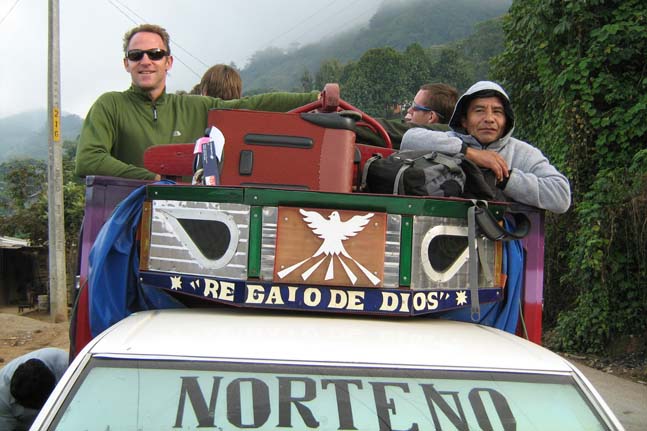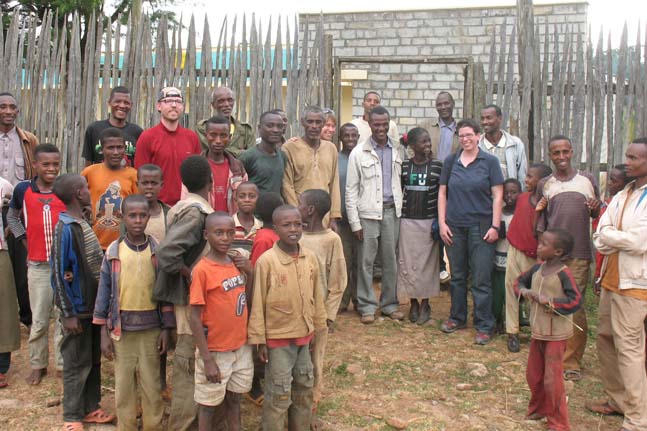
A visit to C.A.C Pangoa, in the Central Jungle of Peru, turned out to be the perfect way to wrap up 2019, and to get ourselves poised to launch into action in 2020.
We arrived in Peru with a group of 22 Coop Coffees roasters, staff and producer partners to learn about Pangoa’s innovative work transforming farmers’ fields into Centros de Excelencia. This was an amazing opportunity to exchange ideas and lessons learned, and to consider best collaborative strategies between producers and roasters, facing forward towards a more sustainable future.
And during our stay, we heard time and again about the incredible power of trees.
Pangoa is comprised of 690 members in 17 producer regions, or regional committees, as they call their membership clusters. Their leading products are green coffee and cocoa. But Pangoa has also developed important local and national markets for roasted coffee, finished chocolate bars, honey, and honey wine and spirits. Pangoa also sponsors a Saturday morning farmer’s market in the town of San Martin de Pangoa where their women’s group sells a wide variety of fresh produce and prepared meals. By unanimous agreement amongst our delegation, the most delicious breakfast in Peru was definitely the one we enjoyed at the Pangoa Farmers’ Market!
Over the course of our 5-day visit, we got a sampling of Pangoa’s Centros de Excelencia from different production regions and saw the positive impact of regenerative practices in coffee and cocoa. Farmers have been applying an array of field solutions, ranging from the production of fortified, organic bocashi compost to stratified agroforestry designs for improved shade, leaf litter and ground cover to protect their soils. We also saw integrated and economically diversified farms, that included: organic vegetables for market and household consumption; a variety of animals raised for manures and meat production; artesian crafts and eco-tourism initiatives; and, a cornerstone practice for each of the farmers we visited — reforestation for carbon-capture and eventually, sustainable lumber harvest.
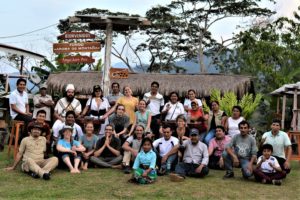 But the most impressive aspect of this work was the sense of deep, personal pride emanating from the farmers themselves, as they explained how the transformational impact they’ve created in their fields has spilled over to improved health and well-being for themselves and their families.
But the most impressive aspect of this work was the sense of deep, personal pride emanating from the farmers themselves, as they explained how the transformational impact they’ve created in their fields has spilled over to improved health and well-being for themselves and their families.
Although each farm we visited was quite distinct, one common message was heard again and again: “Reforestation with a diversity of species and shade strata is foundational to successful management of the land.”
The Power of Trees
Bringing trees back into agricultural production systems, creates many important environmental services. Some of the most important include:
1) The maintenance or improvement of soil fertility. This is a direct result of: the increased organic matter added to the soil; nitrogen fixation and nutrient cycling via a complex, living root-system; and, the physical anchoring of soils against wind and water erosion.
2) Water conservation, both in terms of quantity and water quality. Thanks to the root systems’ capacity to attract microbial life, this dynamic web of biology in soil, builds texture and enhances water infiltration. Meanwhile, trees have an incredible water-cycling capacity: by pumping ground-water to the canopy, leaf respiration, rainfall, and repeat — trees keep water flowing in the localized ecosystem.
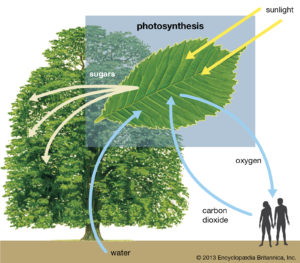 3) Photosynthesis is a fundamental driver of carbon sequestration. As CO2 is absorbed through tiny pores in the leaf surface, this heat-trapping gas is reduced from the atmosphere. And in the meantime, as CO2 molecules are split they liberate oxygen and transform the carbon molecules into carbohydrates and sugars, nourishing the tree and feeding micro-organisms in the soil — a win-win situation for all!;
3) Photosynthesis is a fundamental driver of carbon sequestration. As CO2 is absorbed through tiny pores in the leaf surface, this heat-trapping gas is reduced from the atmosphere. And in the meantime, as CO2 molecules are split they liberate oxygen and transform the carbon molecules into carbohydrates and sugars, nourishing the tree and feeding micro-organisms in the soil — a win-win situation for all!;
and finally, 4) Increasing tree diversity bolsters the overall natural biodiversity, serving micro- and macro-organisms, which in turn makes the entire biological production system healthier and significantly more resilient.
We were able to see for ourselves the positive impact in the field and to hear about their renewed motivation to apply combinations of these innovative practices directly from producers.
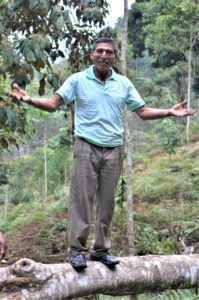 For example, Marcelo Ramos Perez acquired a 17-hectare plot, some 13 years ago, with severely degraded soils and an unreliable water table.
For example, Marcelo Ramos Perez acquired a 17-hectare plot, some 13 years ago, with severely degraded soils and an unreliable water table.
But with his concerted efforts to apply best organic land-management practices, stratified shade-grown coffee, reforesting portions of his land with pine and hardwoods, and diversifying lower elevations with partial shade and cacao as an alternative market crop – Marcelo has recovered both soil health and water supply. In his home patio, Marcelo has small-scale animal production, including chickens, ducks and guinea pigs and produces his own organic foliar sprays and improved composts.
“If I were not part of this organization, I’d be living in a very isolated bubble,” Marcelo said. “I’ve learned so much from my cooperative,” he added, “both from our own technical team and from the coop supporting my participation in regional and international learning exchanges.”
From the improved earnings of this diversified production system, Marcelo has also been able to make improvements to his home, including extending a dedicated room for the kitchen and a more-efficient and clean-burning cook stove – eliminating a common health risk from the smoky alternative of a simple, wood-burning stove.
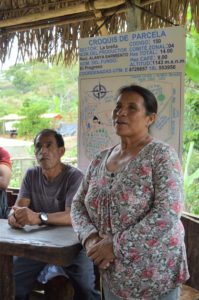 Raul Alanya Sermiento and Carmen Esteban de Alonge own and work their 14 hectares of land (9 ha of which are planted in coffee) with diversification and a thoughtful, integrated system in mind.
Raul Alanya Sermiento and Carmen Esteban de Alonge own and work their 14 hectares of land (9 ha of which are planted in coffee) with diversification and a thoughtful, integrated system in mind.
“When we decided to turn our farm into a Centro de Excelencia, we began by asking ourselves a series of questions,” Raul said. “What to we need to do in order achieve the changes we seek?” “What are our priorities and what obstacles are in our way?”
A key response to Raul’s questions resided in native and commercial tree species. He took us on a walk through his forested areas of Elocarpio and Tecomani pines, where he currently counts some 3,500 trees planted and in different levels of development – both in dedicated forestry parcels and inter-cropped as  shade amongst his coffee trees. This Raul says, has brought soil, water and climate balance back to his land. And watching Raul scramble up the tree trunks to demonstrate his pruning techniques, also illustrated the trees’ rejuvenating power – as they make a 50-something man feel like a kid again!
shade amongst his coffee trees. This Raul says, has brought soil, water and climate balance back to his land. And watching Raul scramble up the tree trunks to demonstrate his pruning techniques, also illustrated the trees’ rejuvenating power – as they make a 50-something man feel like a kid again!
“Some people have questioned me on the choice of combining pine with coffee,” Raul said. “But if you look at the positive results, you have your answer: the pine seems to suppress illness in the coffee, and the overall production yields continue to improve.”
And in fact, the pine trees and Raul’s field renovation plans appear to complement each other beautifully.
Launching the Pangoa Reforestation Project – planting the first 125 trees
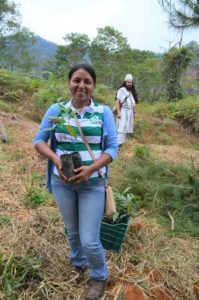 What we saw in the fields only strengthened our commitment to support reforestation. Together with our roaster member Bean North in the Yukon and Grow Ahead, a crowd-funding platform focused on agroforestry and small-farmer solutions to climate change, CoopCoffees has teamed up with CAC Pangoa’s efforts to support reforestation, organized and managed by the Pangoa Women’s Committee. This initiative strives to provide economic opportunities for women and protect lands from the effects of climate change, while investing in the organization’s agricultural transition towards a resilient, regenerative future. During our visit, we were excited to take part in the project launch, planting the first 125 trees. The location for this initial planting was a plot of land collectively owned by Pangoa, strategically placed to maintain the
What we saw in the fields only strengthened our commitment to support reforestation. Together with our roaster member Bean North in the Yukon and Grow Ahead, a crowd-funding platform focused on agroforestry and small-farmer solutions to climate change, CoopCoffees has teamed up with CAC Pangoa’s efforts to support reforestation, organized and managed by the Pangoa Women’s Committee. This initiative strives to provide economic opportunities for women and protect lands from the effects of climate change, while investing in the organization’s agricultural transition towards a resilient, regenerative future. During our visit, we were excited to take part in the project launch, planting the first 125 trees. The location for this initial planting was a plot of land collectively owned by Pangoa, strategically placed to maintain the 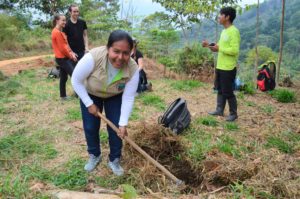 water table that feeds into Pangoa’s micro, hydro-electric production facility. The varieties of trees were selected to provide both biodiversity and other practical services: varying from nitrogen fixing from the legume species Tornillo, to supporting the re-population of local tree species such as Capirona and Buena Maria, to eventual timber harvests from Pino Tacoimani and Cedro.
water table that feeds into Pangoa’s micro, hydro-electric production facility. The varieties of trees were selected to provide both biodiversity and other practical services: varying from nitrogen fixing from the legume species Tornillo, to supporting the re-population of local tree species such as Capirona and Buena Maria, to eventual timber harvests from Pino Tacoimani and Cedro.
 Money raised through this campaign will cover more than just tree planting; the budget also covers technical assistance necessary for best implementation and management of the project, the creation of installation of tree nurseries, the location and planting the tree seedlings, and basic maintenance cost incurred by the Pangoa Women’s Committee.
Money raised through this campaign will cover more than just tree planting; the budget also covers technical assistance necessary for best implementation and management of the project, the creation of installation of tree nurseries, the location and planting the tree seedlings, and basic maintenance cost incurred by the Pangoa Women’s Committee.
Author: Monika Firl
February 11, 2020




